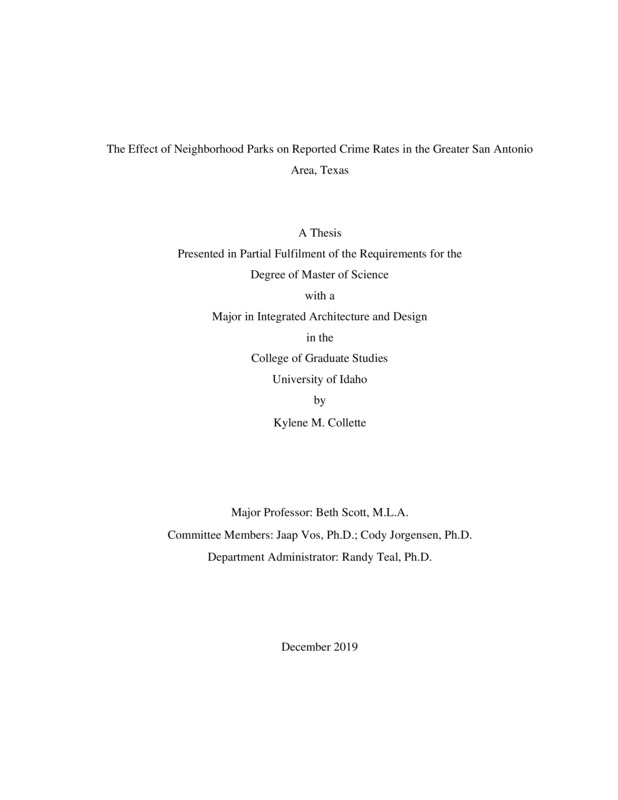The Effect of Neighborhood Parks on Reported Crime Rates in the Greater San Antonio Area, Texas
Collette, Kylene May. (2019-12). The Effect of Neighborhood Parks on Reported Crime Rates in the Greater San Antonio Area, Texas. Theses and Dissertations Collection, University of Idaho Library Digital Collections. https://www.lib.uidaho.edu/digital/etd/items/collette_idaho_0089n_11707.html
- Title:
- The Effect of Neighborhood Parks on Reported Crime Rates in the Greater San Antonio Area, Texas
- Author:
- Collette, Kylene May
- Date:
- 2019-12
- Program:
- Architecture
- Subject Category:
- Area planning & development
- Abstract:
-
Biophilia is a buzzword that is commonly used in society. An increasing body of research points to the benefits of exposure to nature and natural elements. The focus of this study is on how the presence of outdoor parks in a dense urban environment, the greater San Antonio, Texas, area specifically, affects rates of reported crime between 2014 to 2018. Three components make up this investigation. Part one is a macro-level study of six areas, one lower income area with a park and one without, one middle income area with a park and one without, and one upper income area with a park and one without. In each demographic the crime rates in the neighborhood with the park is compared to the one without a park. Across all three income brackets, crime rates decrease in the neighborhood that has the park. The lower income neighborhood shows the greatest significance.
Part two is a meso-level examination of the lower income demographic. Twenty neighborhoods with an annual average income of less than $35,000 are compared. Ten of these neighborhoods have parks and ten do not. The results of this study are less conclusive. Evidence indicates that overall, the presence of a park lowers the rate of reported crime, but not enough to achieve significance.
Part three is a micro-level examination of the results of part two that focuses just on the neighborhoods with a park. The two neighborhoods that have the highest rates of reported crime are analyzed, as are the two neighborhoods with the lowest crime rates. The observation is that, regardless of demographic factors, the parks in neighborhoods that have the lowest crime rates have the following in common: the park appeals to a multi-generational audience; it can be used at multiple times of the day and year; it is well maintained and has a variety of amenities; it has access for people of all abilities, including those in a wheelchair; there is a good balance of natural elements, such as a river and trees, and man-made amenities. The parks that have higher crime rates share these traits: parks are not well maintained, with portions of the park in total disrepair; the park has a narrow audience that would only be used for specific events; there are few amenities that allow the park to be used in all weather conditions; amenities do not encourage social interaction; and landscaping is limited.
- Description:
- masters, M.S., Architecture -- University of Idaho - College of Graduate Studies, 2019-12
- Major Professor:
- Scott, Elizabeth
- Committee:
- Vos, Jaap ; Jorgensen, Cody
- Defense Date:
- 2019-12
- Identifier:
- Collette_idaho_0089N_11707
- Type:
- Text
- Format Original:
- Format:
- application/pdf
- Rights:
- In Copyright - Educational Use Permitted. For more information, please contact University of Idaho Library Special Collections and Archives Department at libspec@uidaho.edu.
- Standardized Rights:
- http://rightsstatements.org/vocab/InC-EDU/1.0/

